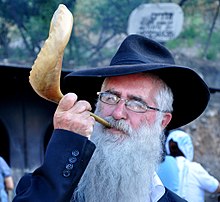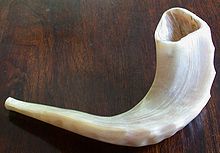Rosh Hashanah
![]()
This article describes the Jewish New Year. For the rabbinic scripture of the same name, see Rosh ha-Shanah (Mishnah).
Rosh ha-Shanah (Hebrew רֹאֹשׁ הַשָּׁנָה 'head of the year, beginning of the year', also Rosh haShanah, in Ashkenazic pronunciation called Rausch ha-Schono or Roisch ha-Schono or popularly in Yiddish Roscheschone, Roscheschune) is the Jewish New Year's Day. The Mishnah, the most important collection of religious traditions of rabbinic Judaism, establishes this festival as the beginning of the year, and from it results the calculation of the calendar years.
The New Year's greeting is שנה טובה shana tova or Ashkenazic (le)schono tauwo 'a good year' or also.
שנה טובה ומתוקה shana tova u'metuka or Ashkenazic schono tauwo u'messuko 'a good and sweet year'. A traditional Ashkenazic New Year greeting is also leschono tauwo tikossëiw 'to a good year may you be inscribed (in the book of life)', which is often supplemented by wessechosëim 'and sealed'.
.jpg)
Greeting postcard, Wiener Werkstätte, 1910
._The_Holiday_Series,_Rosh_Hashanah_(1948),_New_Canaan,_CT.jpg)
Arthur Szyk, illustration of Rosh ha-Shanah, from The Holiday Series, 1948.
Time and embedding in the Jewish calendar
The festival of Rosh ha-Shanah is biblically attested in Leviticus 23:24-25 EU, Numbers 29:1-6 EU, and in outline in Ez 40:1 EU. It begins in the fall, at the end of the day after the 29th day of the Jewish month of Elul. Besides that the Torah also knows a spring date, the 1st of Nisan, as the beginning of the new year Ex 12:2 EU.
Rosh ha-Shanah falls on the 1st of Tishri according to the Jewish calendar, which falls in September or the first half of October according to the Gregorian calendar. The exact date in the Gregorian calendar changes from year to year because the Jewish calendar reckons with twelve lunar months of 29 to 30 days (synodic month 29.53 days). To bring the 354 or 355 days in line with the solar year, a whole leap month is inserted about every three years.
The festival lasts two days in Orthodox Judaism and Conservative Judaism, and thus until the end of the day of the second day of the month of Tishri (even in Israel, where otherwise most holidays are only one day long). The second day was added later. Reform Judaism generally celebrates only the first day of the holiday. There is evidence that Rosh ha-Shanah was celebrated for only one day in Jerusalem until the 13th century.
Rosh ha-Shanah takes place 163 days after the first day of Passover. Under the current Gregorian calendar, Rosh ha-Shanah cannot be before September 5, such as in 1899 and again in 2013. After the year 2089, differences between the Jewish calendar and the Gregorian calendar will mean that Rosh ha-Shanah cannot be before September 6. Rosh ha-Shanah cannot be later than October 5, such as in 1967 and again in 2043. The Jewish calendar is structured so that the first day of Rosh ha-Shanah never falls on a Wednesday, Friday, or Sunday.
Rosh ha-Shanah begins at sunset of the evening before the day listed in the following table, since the Jewish day always begins in the evening. "Then evening and morning became the first day." Gen 1:5 EU
Rosh ha-Shanah dates
| Start in each case on the evening before | |
| Jewish Year | Gregorian date |
| 5781 | 19 - 20 September 2020 |
| 5782 | 7 - 8 September 2021 |
| 5783 | 26 - 27 September 2022 |
| 5784 | 16 - 17 September 2023 |
| 5785 | October 3 - 4, 2024 |
The Samaritans, on the other hand, celebrate Rosh ha-Shanah in the spring, at the beginning of the month of Abib (corresponding to the month of Nisan). Some scholars consider this to be the original All-Israelite custom. The disputes about the timing of Rosh ha-Shanah go back to Talmudic times (Mischnatraktat-Rosh ha-Shanah).
Custom
Rosh ha-Shanah is not a day of mourning, but a festival on which the Jews - because of God's mercy - are to rejoice. Except for the Hallel, which is omitted on New Year's Day, it resembles all other festivals in its ceremonial features: clothing, washing, haircutting, inner preparation and festive meals.
Rosh ha-Shanah is also יום הדין Yom haDin, "Day of Judgment": According to the Talmud (Tractate Rosh Hashanah 16b), three books are opened on the New Year. Into the first are inscribed the completely "righteous," who immediately "receive the seal of life." Into the second book are entered the very "wicked" who receive the "seal of death." And the third book is for the "mediocre" who can show both sin and merit. The final judgment remains open during the period from the New Year's Day to the Day of Atonement. Through repentance and conversion it is possible to receive the seal of life.
Rosh ha-Shanah is a day of blowing the shofar. In the Torah this day is also called the day of the shofar (Lev 23:23-25 EU). It is also called a "day of noise blowing." The shofar is sounded according to mitzvot established in the Torah and Talmud for the morning prayer at the New Year's festival, provided it does not fall on a Shabbat.
The order of prayers, shofar blowing, kiddush and meals that applies to the first New Year's Day also applies to the second New Year's Day. However, it is not a "second holiday" as is customary in the Diaspora for the other holidays. The Talmud designates both days together as one 48-hour holiday. Because of this rule, there is a concern that people may say "unnecessary blessings" at the Shehecheyanu, candle lighting and Kaddish on the second day. To remove these doubts, one generally puts on a new garment on the second day of the New Year and places a bowl on the table containing fruit that one has not eaten at that time of year. One now relates the blessings to it.
In the afternoon of the first day, there is the Taschlich custom of symbolically wiping away sins by throwing stones or bread crumbs into the water after a prayer for forgiveness.
The synagogue is predominantly white on Rosh ha-Shanah, as is the prayer leader. This is to symbolize purity and goes back to the verse, "Our sins shall be made as white as snow." (Isaiahu 1:18)
The blessing after the service is leschana towa tikatewu or Ashkenazic leschono tauwo tikossejwu, "May you be inscribed for a good year". Some groups have developed the custom of visiting graves of relatives and "righteous" people before Rosh ha-Shanah, to be inspired by the memory of their lives for the coming year. On the morning before the New Year, after morning prayers, the "unbinding of vows" takes place (before three appropriate halakhic Jews who have formed a "court" for this purpose).
On Rosh ha-Shanah, special food customs are observed. Eating honey cake (honek-lejkech), zimmes, grapes, sweet wine and slices of apple (or challa) dipped in honey expresses the hope for a good, sweet year. Also, sometimes a symbolic piece of a fish or sheep's head is eaten with the words "May it be your will that we become the head and not the tail". Another custom is to eat pomegranates, which contain many seeds. To this one says, "May it be your will that our rights multiply like the pomegranate." In Yiddish-speaking communities, black-eyed peas (rubiya, pun on rov "many") and Yiddish mern, "carrots" are eaten with the words "May it be your will that our rights multiply." Sometimes dates are also eaten, saying, "May it be your will that our detractors and accusers perish."

A man blows the shofar horn

Small Ashkenazi style shofar
Search within the encyclopedia